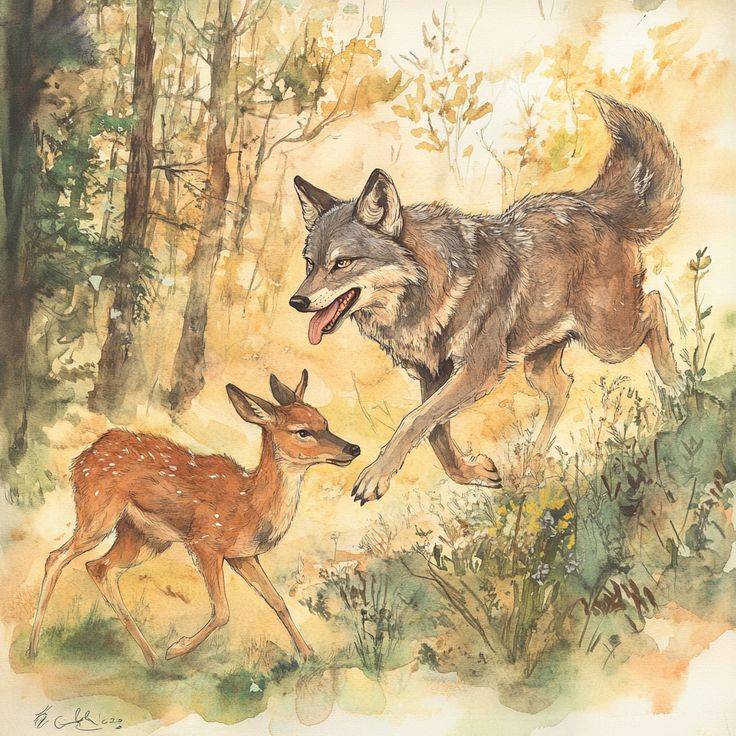The Wolf and the Fawn
A Tapestry of Peace Woven from Power and Grace
Some images linger in the soul, timeless and profound. The vision of a wolf lying beside a fawn, predator and prey at rest, stirs a hope as old as humanity: that strength and gentleness can coexist. Growing up, my grandmother would read me stories of such miracles, her voice soft with wonder. This is a reflection on the ancient promise of harmony, drawn from myth, history, and my own heart, a reminder that even the fiercest divides can mend under the right sky.
The Symbol’s Roots
The image of a wolf and fawn together echoes a biblical prophecy, often tied to Isaiah 11:6, where “the wolf shall dwell with the lamb… and a little child shall lead them.†It paints a world remade, where nature’s fiercest instincts yield to peace. As a child, I’d imagine this scene in the woods behind our house, picturing a wolf’s amber eyes softened by a fawn’s trust. To me, it wasn’t just a verse—it was a possibility, a world where opposites could meet.
I think of my grandfather, a farmer who’d coax wary deer from his fields with quiet patience, never raising a hand. He lived that harmony, strength tempered by care. Scholars note this motif appears beyond scripture—in ancient Sumerian tales or Native American legends, where predators and prey symbolize balance. The wolf and fawn embody power and vulnerability, a king’s might and a child’s innocence, destined to share the same meadow.
A Historical Echo
History offers glimpses of this vision, moments when sworn enemies paused their claws. In 1914, during the Christmas Truce of World War I, British and German soldiers laid down rifles to share songs and soccer in No Man’s Land. I recall my history teacher’s story of her great-uncle, who traded cigarettes with a German private that day, their laughter a fleeting fawn beside the war’s wolf. Such truces, though brief, show humanity’s hunger for peace, even amid blood.
Another echo comes from the 1978 Camp David Accords, where Egypt’s Anwar Sadat and Israel’s Menachem Begin, bitter foes, forged a peace treaty under U.S. mediation. Their handshake, uneasy but real, was a step toward coexistence. Like the wolf and fawn, they didn’t erase their differences but chose to lie side by side, if only for a moment. These stories, rare as they are, prove the metaphor’s power: peace is possible, not inevitable.
The Personal Meadow
The wolf and fawn live in us, too. I’ve felt this in my own life, reconciling my drive to succeed with my need to nurture. Years ago, I clashed with a coworker, our tempers flaring like beasts. But one coffee break, we shared stories of our families, and the fight dissolved. We didn’t become friends, but we worked in peace, our strengths no longer at odds. I think of my friend, who forgave a betrayer after years of anger, her heart a fawn stepping toward a wolf she’d feared.
This inner truce takes work—listening, yielding, seeing the other’s light. My grandmother taught me this, her stories a guide to finding meadows within. Studies in psychology show empathy can bridge divides, reducing conflict by humanizing the “enemy.†The wolf and fawn remind us to pause, to seek the gentle spark in what seems fierce.
A Hope for Tomorrow
The promise of the wolf and fawn isn’t a fairy tale—it’s a challenge. In a world of wars, division, and mistrust, we need their harmony more than ever. I look at my nephew, who asks why people fight, and I tell him about the meadow where all can rest. I think of my grandfather’s fields, where deer grazed unafraid. That vision drives me to listen harder, to act kinder, to believe in peace even when it feels distant.
If you carry a wolf’s strength or a fawn’s grace, know they can meet. Seek the meadow in your heart, your community, your world. Start small—a kind word, a shared story—and watch the divide shrink. The wolf and fawn are waiting, their peace a song we can sing together, under a sky that holds us all.
Ethical Note: This piece is a reflective narrative inspired by themes of peace, coexistence, and symbolic harmony, grounded in biblical and historical references. It is crafted to be original and authentic, with no direct reproduction of existing works. Any resemblance to specific narratives beyond common cultural motifs is coincidental. The content aims to inspire hope and reflection while respecting creative integrity and the depth of the subject matter.


